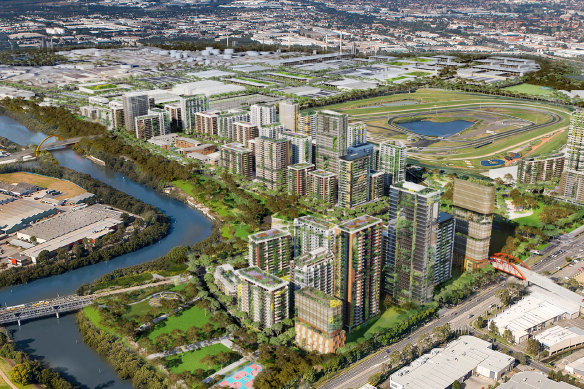- Exclusive
- Politics
- NSW
- Development
This was published 1 year ago
Revealed: 11 Sydney suburbs to be rezoned to fix the housing shortage
By Michael McGowan and Anthony Segaert
More than 3000 sites have been identified by the Minns government as public land suitable for redevelopment as housing, including a string of current and former psychiatric hospitals and disability centres.
The documents – contained in briefings to Housing Minister Rose Jackson and obtained by the Herald under freedom of information laws – also reveal a list of 11 suburbs that have been prioritised for state-led rezoning and could be ready for large-scale development by the middle of next year.

The government’s vision for Camellia-Rosehill, as revealed in the artist’s impression in its November 2022 “place strategy”.Credit: NSW government
In May, Premier Chris Minns ordered his ministers to find vacant blocks of public land to rezone for housing as the new government seeks to boost the state’s flagging supply of new homes.
While the audit is ongoing – a working group of agencies is sifting through the initial tranche of land to decide which sites should be prioritised for development – documents reveal an initial desk-top review of public land unearthed some 3231 “potential sites” for development.
Separately, the documents show a list of 11 suburbs shortlisted for major redevelopment, with rezonings due to be complete by the middle of next year. The list includes Camellia, where developers want the Minns government to put a new Metro station before the development of 10,000 new homes, Eveleigh, Parramatta North, West Schofields and St Leonards.
The list also included a 12th suburb, Broadmeadow, near Newcastle, which has since been put on indefinite hold after Newcastle MP Tim Crakanthorp was referred to the NSW anti-corruption watchdog over his family’s property holdings.
After the Herald on Wednesday revealed the government is considering a shake-up of Landcom to give it an increased focus on building more homes, the documents also reveal the government developer is playing a key role in the audit.
Other sites set for redevelopment include the next stage of the Riverstone East development which could allow 3500 homes to be built, as well as the Macquarie Park development of up to 7650 new properties, Riverwood Estate, Orchard Hills, Marsden Park North and the potential for 850 apartments as part of a proposed redevelopment of the Central Station precinct in the CBD.
Those major redevelopments are in addition to the surplus land being evaluated by the government as part of its land audit.
Among potential development sites identified in the briefing documents is the 43-hectare Macquarie Hospital, a sprawling psychiatric facility set on parkland not far from North Ryde Metro Station.
Minns has been critical of the former government for failing to take advantage of the North West Metro line by adding increased housing density, but Ryde Mayor Sarkis Yedelian insisted he would not support housing on the site because the area was already dense enough.
“Thirty years ago [the state government] wanted to build social housing there [at Macquarie Hospital] and the local community fought against it,” he said.
NSW Health referred questions about the hospital’s future to the Planning Department, which said the government was still “completing due diligence” on the audit.
“There have been no government decisions about individual government-owned sites and we will have more information available in time,” a spokesman said.
The government may only look to develop the expanse of parkland surrounding Macquarie Hospital. But, the Herald has learnt that it is one of a handful of current and former psychiatric facilities which may become surplus to requirements after the former government spent $700 million on new mental health infrastructure projects.
Other potential development sites identified during the audit include Tomaree Lodge, a former residential centre for disabled people on the waterfront in Port Stephens, and the Stockton Centre, an 84-hectare former psychiatric hospital and disability centre near Newcastle which closed in 2020.
Government sources told the Herald that other sites, including the 1200-hectare former Morisset Hospital in Lake Macquarie, are also under consideration for development.
While the initial audit contains more than 3000 sites, the shortlist will be much smaller. The government plans to continue rolling updates of surplus public land to be made available for development.
Internal briefings show Landcom is one of a handful of agencies told to whittle down the list of sites to decide which should be prioritised for housing. Senior government sources said the state-owned corporation could play an important role in potentially developing sites.
Minister for Land and Property Steve Kamper said while due diligence on the audit continued, finding new housing was the government’s “top priority” and there was “an opportunity for Landcom to do more”.
“The land audit has found thousands of potential sites. Due diligence is ongoing, with availability, suitability, and compliance checks still to be completed,” he said.
Katie Stevenson, the NSW executive director of the Property Council, welcomed the government “looking exhaustively and creatively at all the levers they can pull to address the housing supply and affordability crisis”. But she warned of unintended consequences if it was pushed into competition with private developers.
“Landcom [has] been really effective in the past at delivering sites, but it’s important that we partner with each other so that we complement rather than compete with the government development arm,” she said.
The Morning Edition newsletter is our guide to the day’s most important and interesting stories, analysis and insights. Sign up here.